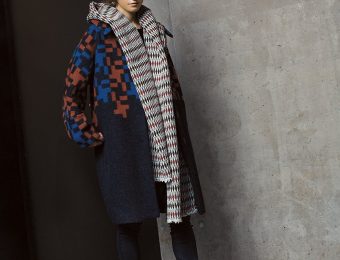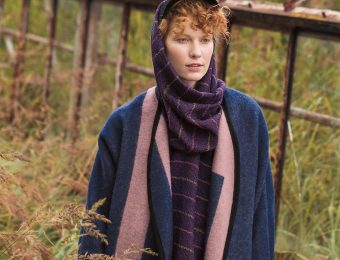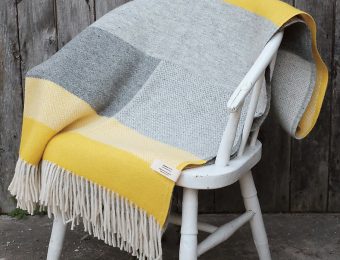Evelin Kangur Talks with Textile Designer Mare Kelpman
Mare Kelpman has had a sensational year of celebrations, to say the least: winning Textile Designer of the Year 2018, which she was also previously awarded in 2003 and 2011, the Silver Needle award by Tallinn Fashion Week, and the Italian Vogue SS18 photo shoot by Maiken Staak. Born in Saaremaa, her brand, Kelpman Textile, is an antidote to the prevailing Scandinavian minimalism. Looking at her current body of work, two repertoires stand out: 1) an opulence of colors and patterns requiring a decent zoom-in, which reveals a microcosm of wool threads that constitute a more complex pattern, and 2) dominating colors, either in relation to each other or in contrast, depicting a distant view of clear geometric shapes.
Celebrating her 60th birthday this summer, the textile designer has disproved the idea of wool as something that childhood nightmares are made of. Living and working in Kalamaja, a vibrant neighborhood in the capital of Estonia, Mare relentlessly seeks ways to revive a material that has been used for centuries.
I talked to the designer about the practicalities of owning a small business and negotiating artistic expression, and looked back at the moments that have shaped her work.
Evelin Kangur (EK): How did an island girl end up in the university town of Tartu?
Mare Kelpman (MK): This teenage girl from Saaremaa wanted to exceed the boundaries of an island, see more, experience more. Tartu, being distant and nerve tingling, had the potential to make these desires come true. At Tartu Art School I studied art on a broad scale and found affirmation in the vocation; of course the bohemian lifestyle was inescapable. I took up textile studies years later in Tallinn at the Estonian Arts Academy.
EK: Textile design wasn’t your first choice, so how did you end up there?
MK: I became a mother and, working at home in the pre-computer days, I collaborated on cartoons and drew pictures, made tables for publishing houses and even hand-drew tablature at one point. When an opportunity came to restart my studies, I chose a subject that had stuck with me since childhood: textile design. Earlier, I had dreamed about becoming a painter. Looking back, I’m grateful to my former self for the wise decision.
EK: What are your early memories of noticing design around you, whether in your parents’ home or in the city?
MK: My mother was good at drawing and made handicrafts. I was brought up in a creative environment and at an early age started to experiment with different techniques, such as knitting and sewing clothes for dolls. The sea played a considerable role in forming me; our home was bordered by the sea, and the overwhelming feeling of freedom the sea provides is something I try to preserve. The sea sparked my creativity. I would wake up at dawn to paint the sunrise on the veranda.
EK: A large portion of the public knows you for your brand Kelpman Textile, but before that you were a professor and department manager of textile design studies in the Estonian Academy of Arts. What state of mind did you have back then and how did it manifest artistically?
MK: I was involved with the Estonian Academy of Arts (EAA) for almost 20 years, first as a lecturer and associate professor and eventually as the head of the textile design department. That was an active period of revamping the study environment and modernizing curricula. My personal creative aspirations were not a priority. During my time at EAA, my work was displayed in curated exhibitions and in some personal exhibitions. I have always been interested in exploring the possibilities of technologies and materials: how to use technology to perform ideas or the other way around. Now common, but novel in those days were laser cut fabric, 3D and Jacquard weaving, which I explored.
EK: When and how did the shift from exhibition items to consumer goods occur?
MK: The designer way of approaching things, which primarily considers the modes of use and function, is central to my work, and this is what I communicated to students as well. I do not consider an exhibition work in any way superior to a well-produced and useful textile product. The latter needs even more expertise, effort and attention to detail.
EK: The early days of Kelpman Textile revolved around home accessories, whereas now fashion items seem to dominate. Do you think of yourself as a textile designer or a fashion designer?
MK: Home textiles are an important part of my work and I intend to continue expanding the collection. Designing clothing was motivated by curiosity and challenge. Industrial weaving machines from the 70s that I use for the majority of my textiles provide limited technological advantages. I wanted to explore whether I could manage to weave textiles suitable for apparel and also construct the right cuts. The process was full of trials and errors and continues to be so.
I’m not a manufacturer, and I need challenges and problems to solve. I consider myself a textile designer who explores fashion design. My primary medium is textile and, since every fabric should have an objective, the selection of products increases. I’m not interested in creating fashion of the moment, but rather in following a distinct style that will contribute to the well-being of its wearer. I intend to create jackets, coats and dresses that won’t be embarrassing to wear in 10 years.
EK: It’s impossible to avoid talking about sustainability when talking about textiles and fashion: what earth-friendly practices have you incorporated into your company and designs ?
MK: I weave my textiles using yarn from nearby countries, the production chain is transparent and I know that the materials are manufactured in the best possible way. Local production enables us to cut back on transportation mileage. It’s crucial to produce in accordance with demand. I do not hold on to stock and try to increase product range with special editions. I haven’t found a path to zero waste production, but we are very close. Most of the leftovers from apparel production are re-used in new items.
EK: Is sustainability the new luxury?
MK: Definitely for a small business because production costs are much higher due to the high quality of materials and the low quantity of items made. But I believe that things are shifting back to small, local production; it’s impossible to keep using lavish and exhaustive methods connected with environmental and human resources. The consumer must determine the direction, but there’s still a major gap in knowledge regarding the amount of effort and work a piece of clothing requires. Something is entirely wrong if a dress costs less than a sandwich: then someone is working for free. Consumers are becoming more conscious and don’t necessarily see sustainable items as luxuries, but rather as long-lasting products in which value corresponds to cost. Sustainable production and consumption are the only ways to have a future.
EK: How does the islander identity translate to your oeuvre?
MK: Saaremaa has embedded a certain aesthetic sensitivity in my genes. The nature on the island is rather poor, the soil is thin and the eye can travel to the horizon. One has to focus on the abundance of shades and patterns in the background. The effect of the rich colors that the neighboring islanders of Muhu wear, lingers with me to this day. Growing up on Saaremaa gave me a sense of freedom and assurance that every situation was manageable, which is invaluable for a small business owner.
EK: Why wool?
MK: Why not? You’re not suggesting polyester, are you? I like to study new innovative fabrics and seek ways to use them, but in products that surround us on a daily basis I can’t deal with anything but natural components. In our boreal climate zone, we need protection from the harsh conditions most of the year. I needed to make wool modern and make it attractive to the customer, as the wool scarf was perceived as an archaic object. Just recently people would wear ugly acrylic or paisley patterned scarves bought on all-inclusive resort trips.
EK: How has the role of shopkeeper influenced your artistic expression?
MK: It has made me more cautious. Today I have to make enough to meet tomorrow’s rent, salaries and materials. On the other hand, owning a shop allows me to establish my own imaginative world, with diverse selection and transparent prices. Of course I think about buyers’ preferences, but that has to follow my artistic expression, not precede it.
EK: Your work is warmly received by the Japanese market. Why do you think it appeals to their sense of aesthetics and where else have you found partners?
MK: I think the Japanese understand exceptional and wholehearted design. My work resonates with people who live discreetly in tune with nature and have acquired the expertise needed to deal with four seasons. Most of our wholesale partnerships have been and continue to be project-based, and have the potential to become permanent in the near future. In the Nordic countries, my designs can be found at the TRE shop in Helsinki.
EK: Do you have any interest in conquering international markets?
MK: I have no interest in conquering anything merely to achieve prominence. When I established my own company, I thought I had to focus exclusively on export, but that meant an expensive investment that might prove to be cost effective only in the distant future. I don’t have that kind of time. I’m in pursuit of the present. Assuming that the local audience might not appreciate wool items, I visited a number of international trade shows and design markets in the early years of my business and gained the confidence to actualize my ideas. All of my current partners have discovered me in one way or another, and I have collaborated with many acclaimed brands, but the whole process has to be enjoyable, a source of inspiration.
EK: Your designs are not only local in the Estonian sense, but the former fishing village of North-Tallinn, now called Kalamaja, is your natural habitat. It’s also the neighborhood with the highest concentration of Kelpman Textile design items visible on the street and where locals instinctively stop to greet you. Why do you think your creation delights people?
MK: The Kalamaja area has the highest concentration of young creative people, who care about global issues, have explored foreign cultures and can distinguish high-quality products from poor-quality ones. I’m not creating glamour, but a style for those who are able to appreciate it.
EK: What are the major changes in textile design and technology you’ve witnessed during your career?
MK: Studying textiles in the Soviet era, the selection of materials was scarce and wool was mainly used to weave carpets, which was rather dull. The fast progress in textile technology that followed has introduced opportunities to utilize textiles everywhere, from architecture to warfare. Innovation in the field boosted my enthusiasm for smart textiles, and I started to explore those in the EAA with Professor Martin Pärna; we made an electrical circuit and color-shifting fabrics. University management at the time glared at my project with suspicion and preferred more conventional tapestry-weaving techniques. Interestingly, the study of innovative technologies and materials has brought me back to basics. I find joy in making textiles in an old-fashioned way. Old is the new fashion!
EK: Kelpman Textile is a family business. What responsibilities do you assign to your son? Has your granddaughter received a crash course in textiles already?
MK: My granddaughter is a frequent visitor to my Telliskivi [Creative City] studio and I’m pondering ways to evoke zeal for textiles and work in her. I’m hoping to teach her something necessary for her life ahead. My son assists me with the many tasks present in a small business, and he contributes as a critic at large.
EK: As a former professor, are you content with the current state of textile and fashion design?
MK: I try to be attuned to current affairs in the textile industry and keep my antenna extended for Estonian-specific development. I believe that active young people always find ways to participate in programs that help to stimulate artistic ventures in the field, but I do wish there were more opportunities.
EK: What’s next for Kelpman Textile ?
MK: I have plenty of ideas, so let’s see how they manifest themselves.
Kelpman Textile at Telliskivi Creative City
Telliskivi 60A Tallinn
http://www.marekelpman.eu





